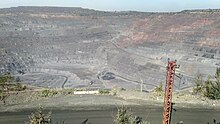Kryvyi Rih metropolitan area | |
|---|---|
 | |
| Largest cities | |
| Area | |
| • Metro | 19,919 km2 (7,691 sq mi) |
| Population (2019) | |
| • Metro | 1,170,953 |
| • Metro density | 59/km2 (150/sq mi) |
Kryvyi Rih metropolitan area, or Kryvbas, is a metropolitan area in central (by the most part) and southern Ukraine. With a population of one million, it is one of seven largest metropolitan regions (million-plus each) in Ukraine. It consists of a couple big industrial cities and some smaller ones, townsides and rural areas.
Contents
- History
- Russian Empire
- USSR
- Independent Ukraine
- Economy
- Largest companies
- Largest holdings represented
- Transport
- Public transport
- Road transport
- Air transport
- Notes
From east to west, the region includes the cities of Kryvyi Rih, Zhovti Vody, Oleksandriia, Dolynska, Novyi Buh as well as parts of the more rural raions and (factually) includes far more territories in central and southern parts of Ukraine. The Kryvyi Rih metro area doesn't have an administrative center, each city in the area has its own administration.





